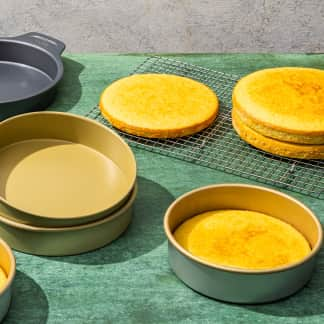A Bundt pan is a special tube pan with decorative ridges or fluting. It was introduced in 1950 by Nordic Ware at the request of a Minneapolis-area Jewish women’s group whose members wanted a lighter, easier-to-use version of the ring-shaped cast-iron pans used to make kugelhopf, a Central European yeast cake. But the pan didn’t truly start to become popular until 1966, when a chocolate Bundt cake called the Tunnel of Fudge took second place in the Pillsbury Bake-Off. Sales boomed as home bakers across the country sought to make this cake for themselves. Today, Bundt pans are a common sight in kitchens everywhere.
We wanted to find the best Bundt pan—one that would be easy to use and would effortlessly release attractive, evenly browned cakes. So we bought seven 11- to 15-cup nonstick pans priced from about $10.00 to about $30.00 and used them to make our Classic Yellow Bundt Cake.


We were pleased to learn that all the Bundt pans made excellent, consistently browned cakes. Pans with dark interiors produced cakes that were a slightly deeper brown but were still entirely acceptable. Better still, all the pans released the cakes equally well, with no sticking. Capacity wasn’t an issue—because the pans differed primarily in height but not in diameter, 11.25-cup and 12-cup models produced cakes that had about the same dimensions as the one made in the 15-cup pan. And although we were concerned that some of the smaller pans might not be big enough to hold larger doughs—like our yeast-raised Monkey Bread—as they proofed and baked, even the 11.25-cup models did a fine job of containing the risen dough.

In the end, it was the design of each pan that mattered most—and specifically how that design affected ease of use and cake appearance. We preferred pans with handles, which made them easier to maneuver while greasing them, removing them from the oven, and turning out cakes. And we liked pans that had sharp, well-defined ridges because they produced more attractive, impressive-looking cakes than pans with gentle waves or fluting. As in our last testing, the Nordic Ware Anniversary Bundt Pan reigned supreme. It had thick, easy-to-grip handles, and it turned out perfectly browned cakes with dramatic peaks and valleys.
The Tests:
- Measure capacity
- Bake Classic Yellow Bundt Cake and turn out of pan
- Proof and bake Monkey Bread in smallest pan
- Wash by hand 10 times and examine for damage
How We Rated:
- Ease of Use: Pans that had handles were easier to grip and flip; they received more points.
- Cake Appearance: We gave more points to pans that had deep, well-defined ridges or fluting.
- Release: Pans that released the cakes easily received full points.
- Handles
- Browns evenly
- Nonstick surface that releases cakes cleanly
- Deep, well-defined ridges
















